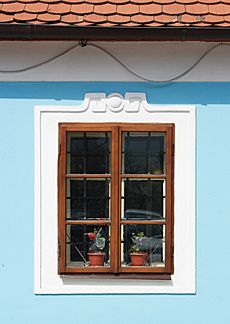Chambranle facts for kids
A chambranle (say "sham-bran-l") is a special kind of frame or border. You usually see it around doors, large windows, or fireplaces. It's like a decorative trim that goes around three sides of an opening. Chambranles can be made from different materials, like stone or wood.
Think of it as a fancy frame that makes an opening look more complete and beautiful. If a chambranle is very simple and doesn't have many decorations, it might just be called a "band," "case," or "frame."
A chambranle has three main parts:
- The two side pieces, which are called montants or ports.
- The top piece, which is called the traverse or supercilium.
Sometimes, people use simpler names for chambranles depending on where they are. For example, the chambranle around a door is often called a "doorcase." The one around a window is a "window frame," and the one around a fireplace is a "manteltree."
Contents
What is a Chambranle?
A chambranle is a decorative border that frames an opening in a building. It's often found around doors, windows, and fireplaces. This frame adds a finished look and can be simple or very fancy. It helps to define the space and make it look more elegant.
Materials Used
Chambranles can be made from various materials. The choice of material often depends on the style of the building and what is available.
- Stone: Stone chambranles are very strong and durable. They are often seen in older, grand buildings like castles or cathedrals. Stone can be carved with intricate designs.
- Wood: Wooden chambranles are common in many homes. Wood can be shaped, painted, or stained to match the room's decor. Different types of wood, like oak or pine, can be used.
Parts of a Chambranle
Even though a chambranle looks like one piece, it's actually made of three parts that fit together.
- Montants (or Ports): These are the two vertical (up-and-down) pieces that form the sides of the frame. They stand tall on either side of the opening.
- Traverse (or Supercilium): This is the horizontal (side-to-side) piece that sits across the top of the opening. It connects the two montants.
History of Chambranles
The idea of framing openings in buildings is very old. In ancient times, people used similar decorative borders. These early frames were known by a different name: antepagmenta.
Ancient Antepagmenta
In ancient architecture, antepagmenta were the decorations or frames around doors and windows. They could be made from stone or timber (wood). The word "antepagmenta" comes from Latin, an old language spoken by the Romans. Over time, this idea of a decorative frame evolved. The English word "chambranle" eventually came to describe these entire door or window frames.
Chambranles are a great example of how architecture combines usefulness with beauty. They don't just hold things in place; they also add a touch of art to our buildings.
See also

- Door
- Window
- Fireplace
- In Spanish: Chambrana para niños


